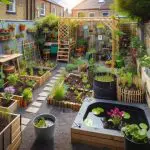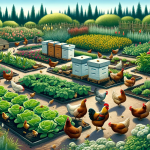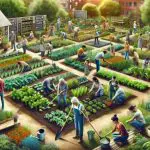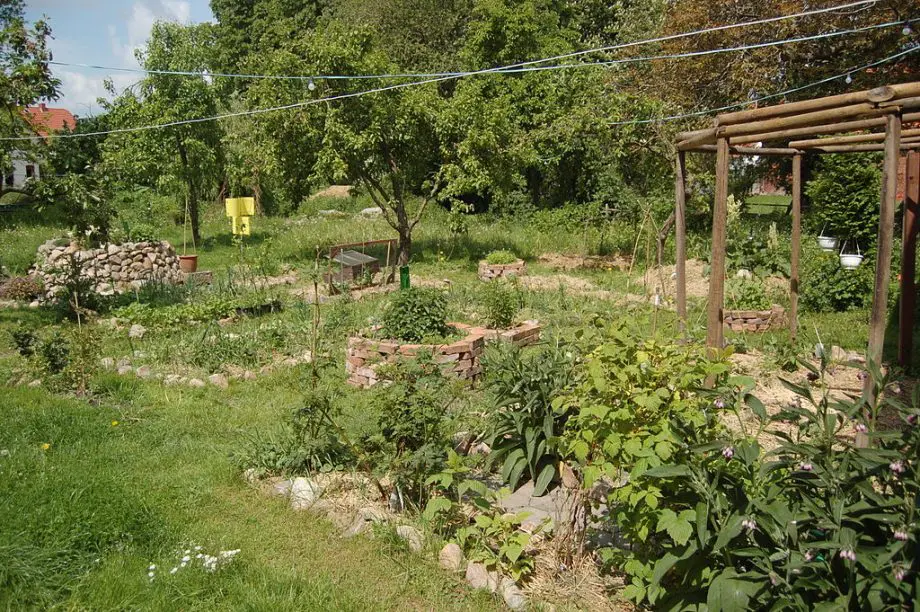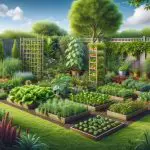
Discover how to integrate permaculture principles in urban environments, transforming city spaces into sustainable, green havens. Learn practical tips for urban permaculture!
Urban Permaculture Key Takeaways:
- Permaculture principles in urban environments involve adapting sustainable agriculture techniques to city spaces.
- This includes using vertical gardens, rooftop plantations, and community gardens
- This creates self-sustaining ecosystems that enhance urban biodiversity and promote local food production.
Ever wondered how to integrate permaculture principles in urban environments? Well, you’re in the right place!
Join us as we dive into the exciting world of urban permaculture, where city living meets sustainable gardening.
We’ll explore creative ways to bring greenery and sustainability into the heart of the urban jungle, making our cities greener, one garden at a time!
How To Integrate Permaculture Principles in Urban Environments
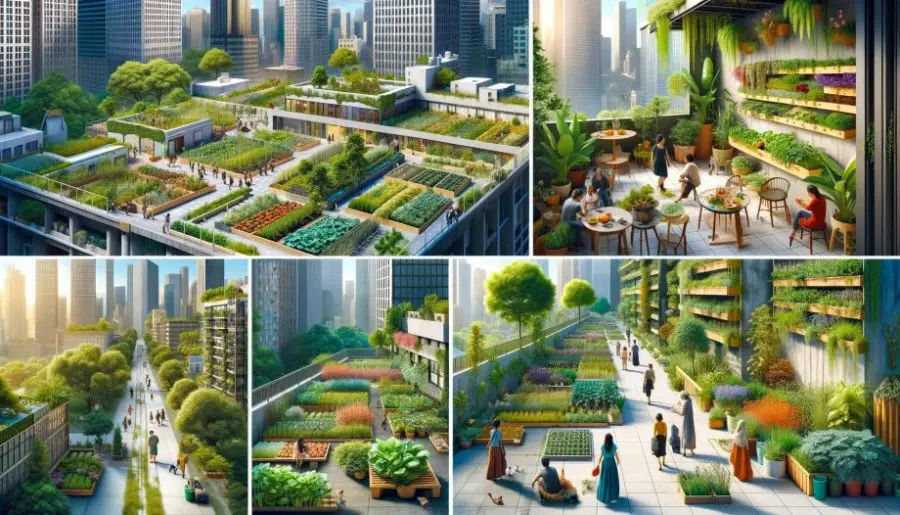
In an era where urban landscapes dominate, integrating permaculture principles presents a unique opportunity to revitalize our connection with the natural world using principles of permaculture design.
Urban environments are often bustling and disconnected from natural ecosystems.
Urban permaculture is possible even without owning private property and balconies and vacant lots can be transformed into sustainable, productive spaces.
This approach not only addresses climate change and food security but also enhances the quality of life for urban dwellers.
Through permaculture, we can create holistic, sustainable systems that align with the rhythms of nature even in the smallest urban spaces.
Let’s explore how permaculture can be a game-changer in urban areas, offering a fair share of benefits to all.
Urban environments can benefit from permaculture most — birds, butterflies, and other small animals can shelter and feed on the plants and water sources. People can grow and harvest organically grown food. And the concrete environment surrounding the garden is softened by the plants and flowers that grow. Here are other ways permaculture in an urban environment can benefit a community. Permaculture News
Understanding Permaculture Principles in Urban Areas
Permaculture, a concept pioneered by Bill Mollison and David Holmgren, is more than a gardening technique; it’s a holistic approach to living sustainably within our natural environment.
In urban settings, where concrete often replaces greenery, applying permaculture principles can lead to significant positive impacts.
These principles guide us to work harmoniously with nature, creating sustainable systems that enhance urban food production, improve climate resilience, and foster community connections.
Let’s delve into how these principles can be adapted to the unique challenges and opportunities of urban environments.
The Core Ethics of Permaculture
- Earth Care: This fundamental ethic emphasizes the importance of preserving natural resources and ecosystems. In urban settings, this could involve creating green roofs or utilizing vertical gardens to increase greenery and reduce the carbon footprint.
- People Care: Focused on supporting and nurturing human beings, this principle encourages the development of community gardens and urban food forests, creating spaces where urban dwellers can connect with nature and each other.
- Fair Share: It promotes equitable distribution of resources and benefits. In urban permaculture systems, this might involve sharing the harvest from communal gardens or implementing rainwater harvesting systems to efficiently utilize this precious resource.
Principles in Practice
- Observe and Interact: By observing natural systems already present in urban areas, we can design permaculture gardens that fit seamlessly into the urban fabric, providing habitats for beneficial insects and addressing specific environmental challenges.
- Catch and Store Energy: Urban permaculture projects can harness solar energy or utilize rain barrels for water management, demonstrating energy efficiency in an urban context.
- Obtain a Yield: Whether growing your own food in small urban spaces or cultivating native plants, permaculture in urban environments focuses on producing nutritious food and other useful yields.
- Apply Self-Regulation and Accept Feedback: This principle is about adapting and evolving urban permaculture practices based on feedback from the environment, ensuring that these practices remain effective and sustainable.
Through these principles and a design approach that respects the built environment and private property, urban permaculture not only supports sustainable living but also contributes to the creation of resilient, vibrant urban communities.
Adapting Permaculture in Urban Spaces
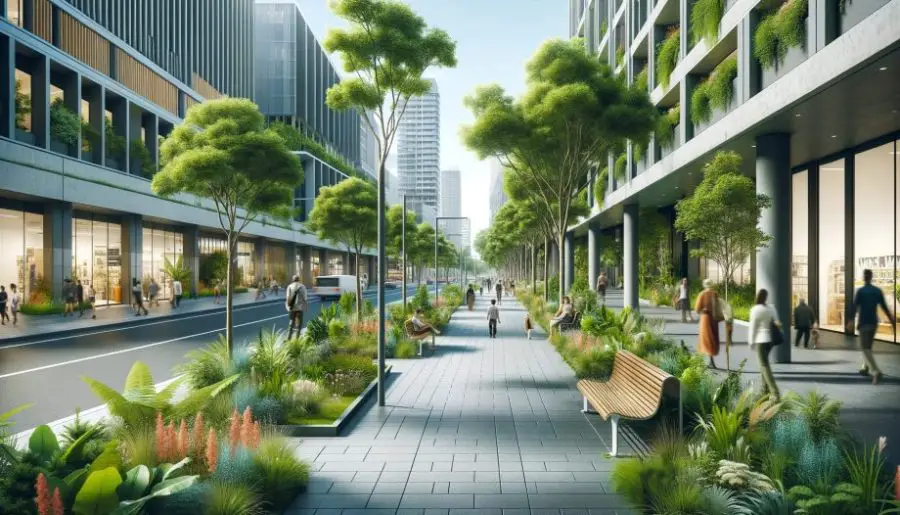
Urban areas, with their unique challenges such as limited space and dense infrastructure, require innovative approaches to integrate permaculture principles.
By reimagining how we use our urban environments, we can create sustainable systems that not only enrich the natural ecosystem but also offer practical benefits to the community.
This section explores how permaculture can be adapted to thrive in the concrete jungle, turning challenges into opportunities for positive change.
Utilizing Small Spaces Effectively
- Vertical Gardening and Green Roofs: Utilizing vertical space is a key strategy in urban permaculture. Implementing vertical gardens and green roofs can turn underused spaces like walls and rooftops into productive areas, growing edible plants and providing habitats for wildlife.
- Container Gardening: For residents with limited ground space, container gardening offers a flexible solution. Whether it’s on balconies, patios, or windowsills, containers can host a variety of plants, from herbs to small fruit trees, making efficient use of available space.
Community Engagement
- Community Gardens: These spaces not only provide fresh, nutritious food but also serve as hubs for social interaction and education. By involving local residents in the creation and maintenance of these gardens, urban permaculture fosters a sense of community and collective responsibility.
- Education and Workshops: Organizing educational programs and workshops in community gardens can further spread awareness about permaculture techniques and sustainable living, empowering urban dwellers to make positive changes in their own spaces.
Water Management in Urban Settings
- Rainwater Harvesting: Implementing rain barrels and other rainwater harvesting systems in urban gardens can significantly enhance water efficiency. This is crucial in cities where water management is a key concern.
- Sustainable Drainage Systems: Permaculture designs in urban areas can include sustainable drainage solutions that mimic natural water cycles, reducing the impact on municipal water systems and mitigating the risk of flooding.
Through these adaptations, permaculture in urban environments transforms the challenges of limited space and resources into opportunities for creating sustainable, productive, and harmonious living spaces.
This holistic approach not only improves the ecological balance but also enhances the quality of life for urban residents.
Practical Steps to Implement Urban Permaculture
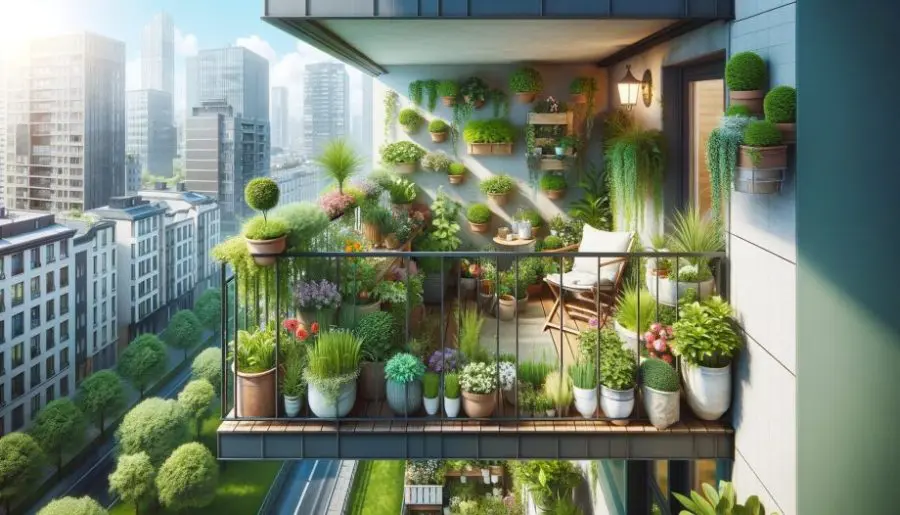
Implementing permaculture in an urban setting requires a blend of creativity, planning, and a deep understanding of permaculture principles.
This section outlines practical steps for urban residents to embark on their permaculture journey, turning their urban spaces into sustainable ecosystems that align with the natural world.
Observation and Interaction
- Assess Your Urban Environment: Start by observing the natural and built elements in your space. Identify sunny spots, prevailing winds, and natural water flow. This information is crucial for deciding where to place gardens, rain barrels, and other permaculture elements.
- Engage with Local Urban Permaculture Communities: Connect with local permaculture groups or attend workshops to gain insights and ideas. Learning from others’ experiences can provide valuable guidance and inspiration.
Designing Your Urban Permaculture Space
- Start Small and Simple: Begin with manageable projects like a small herb garden or a single rain barrel. This first step allows you to learn and adjust as you go.
- Incorporate Permaculture Design Principles: Plan your space considering permaculture principles like energy efficiency, sustainable use of resources, and creating habitats for beneficial insects. Each element should serve multiple purposes and work in harmony with others.
Sustainable Practices
- Companion Planting: Utilize companion planting techniques to maximize space efficiency and encourage natural pest control.
- Compost and Soil Health: Start a compost system to recycle organic waste and improve soil fertility. Even in a small urban space, methods like vermiculture can be effective.
- Water Conservation: Implement rainwater harvesting and efficient irrigation systems like drip irrigation to make the best use of this precious resource.
These steps, tailored to the unique conditions of urban environments, can guide individuals and communities toward establishing thriving permaculture systems.
By taking these actions, urban dwellers can significantly contribute to sustainable living and ecological balance.
Urban Permaculture Gardening
Urban gardening, a cornerstone of urban permaculture, offers innovative ways to cultivate food and support biodiversity in limited spaces.
This section provides practical tips for urban residents to develop productive and sustainable gardens, leveraging small spaces to create impactful ecological benefits.
Choosing Suitable Plants
- Selecting for the Urban Climate: Choose plants that are well-suited to your specific urban microclimate. Consider factors like sunlight exposure, temperature variations, and air quality when selecting plant species.
- Edible and Native Plants: Focus on edible plants like vegetables, herbs, and fruit trees that can thrive in small spaces. Incorporating native plants supports local biodiversity and attracts beneficial insects.
Innovative Gardening Techniques
- Vertical and Container Gardening: Utilize vertical structures for growing climbing plants like beans and cucumbers. Containers are great for balcony or rooftop gardens, allowing flexibility in managing soil quality and sunlight exposure.
- Permaculture Techniques in Small Spaces: Apply permaculture techniques such as companion planting, layering (using different plant heights), and succession planting to maximize yield and maintain soil health.
Creating Biodiversity Hotspots
- Attracting Pollinators: Design your garden to attract pollinators like bees and butterflies, which are crucial for maintaining healthy ecosystems. Plant a variety of flowering plants that provide nectar throughout the growing season.
- Building Habitats for Wildlife: Incorporate features like bird feeders, insect hotels, and small water features to create a welcoming environment for wildlife, enhancing the urban garden’s ecological value.
Urban permaculture gardening not only contributes to food production and sustainability but also enriches the urban experience, creating green havens that benefit both people and the environment.
Community Involvement and Education
Urban permaculture goes beyond individual gardens to encompass community-wide initiatives and education.
This section explores how urban permaculture can foster community spirit and educate individuals, particularly the younger generation, on sustainable practices and food systems.
Cultivating Community Gardens
- Creating Shared Spaces: Community gardens are vital in urban permaculture, offering spaces where residents can grow their own food, share knowledge, and build relationships.
- Diverse Participation: Encourage the involvement of people from different backgrounds to foster a diverse and inclusive community. This diversity can lead to a variety of gardening techniques and cultural exchanges.
Educational Opportunities
- Workshops and Training: Organize regular workshops on permaculture practices, sustainable living, and gardening techniques. This can be an effective way to engage and educate community members, especially urban dwellers unfamiliar with agricultural practices.
- School Programs: Collaborate with local schools to integrate permaculture principles into the curriculum. This helps children understand the importance of sustainable food production and ecological principles from a young age.
Fostering a Sense of Ownership
- Volunteer Programs: Implement volunteer programs where community members can contribute to the maintenance and development of the gardens. This instills a sense of ownership and responsibility towards the shared space.
By integrating these aspects, urban permaculture can become a catalyst for building resilient communities, enhancing food security, and fostering a deep understanding of sustainable living among urban residents.
Permaculture and the Urban Environment
Urban permaculture brings transformative potential to city landscapes, addressing critical issues like food security, ecological balance, and community well-being.
This section explores the multifaceted benefits of integrating permaculture principles into urban environments, showcasing how these practices can contribute to more sustainable and harmonious urban living.
Addressing Food Deserts and Security
- Local Food Production: Urban permaculture gardens can significantly reduce food deserts, especially in areas lacking access to fresh produce. Rooftop gardens, balcony planters, and community gardens can provide fresh, nutritious food, contributing to food security.
- Resilience Against Climate Change: Urban gardens help mitigate the urban heat island effect, contributing to cooler city environments. They also support biodiversity and can serve as carbon sinks, aiding in the fight against climate change.
Enhancing Urban Lifestyle
- Mental and Physical Health Benefits: Gardens offer urban dwellers a chance to connect with nature, which is known to improve mental health. Engaging in gardening activities can also provide physical exercise and stress relief.
- Community Cohesion and Education: Urban permaculture projects can become hubs for community interaction and learning. They offer spaces for sharing knowledge, skills, and resources, thus strengthening community bonds and fostering social cohesion.
Sustainable Urban Development
- Eco-Friendly Urban Design: Permaculture principles encourage sustainable urban planning, promoting green spaces and biodiversity in urban designs. This can lead to more sustainable, livable cities.
- Innovative Use of Urban Spaces: Permaculture practices demonstrate efficient use of urban space, turning underutilized areas into productive and ecological landscapes. This includes transforming vacant lots into gardens and installing green roofs on buildings.
Urban permaculture not only enriches the environment but also enhances the quality of life for urban dwellers, making it a key component in the pursuit of sustainable urban development.
Navigating Challenges and Embracing Future Trends in Urban Permaculture
Urban permaculture, while promising, comes with its unique set of challenges.
As we look towards the future, understanding these hurdles and emerging trends is crucial for the evolution and success of sustainable urban living.
This section delves into the common obstacles faced in urban permaculture and explores the future directions and innovations shaping this field.
Addressing Common Challenges
Implementing urban permaculture is an innovative solution for sustainable city living, but it’s not without its challenges.
This section addresses the common obstacles encountered in urban permaculture, such as space constraints, regulatory barriers, and resource limitations.
We’ll explore practical strategies and solutions to overcome these hurdles, ensuring that permaculture can be effectively integrated into the urban fabric.
Understanding and navigating these challenges is essential for anyone looking to create successful and sustainable permaculture systems in urban environments.
- Space Limitations: Innovations in vertical and rooftop gardening are providing solutions for space constraints in dense urban areas.
- Regulatory Hurdles: Navigating zoning laws and regulations can be a major challenge. Advocacy and community engagement are key to influencing policy changes that support urban permaculture.
- Resource Accessibility: Ensuring access to necessary resources like water and organic materials in urban areas requires creative solutions, such as community composting programs and rainwater harvesting systems.
Future Trends and Innovations
As urban permaculture continues to evolve, staying abreast of future trends and innovations is essential for those looking to harness its full potential.
This rapidly progressing field is being shaped by technological advancements and new approaches to urban living.
In this section, we explore the cutting-edge trends and groundbreaking innovations that are setting the course for the future of urban permaculture.
From smart technologies to novel urban planning strategies, these developments promise to enhance the efficiency, impact, and reach of permaculture practices in urban environments, paving the way for a more sustainable and resilient future.
- Technology Integration: The use of technology in urban permaculture, like smart irrigation systems and sensor-based monitoring, is on the rise, promoting efficiency and data-driven decision-making.
- Urban Planning Integration: There’s a growing recognition of the importance of integrating permaculture principles into urban planning and development. This includes creating green corridors, community garden spaces, and sustainable drainage systems.
- Community-Led Initiatives: Grassroots movements and community-led initiatives are becoming increasingly significant in shaping urban permaculture landscapes, emphasizing local needs and collaborative efforts.
Policy and Urban Planning
The integration of permaculture principles into policy and urban planning is crucial for the sustainable transformation of urban landscapes.
This section delves into the pivotal role that policy decisions and urban planning play in the facilitation and growth of urban permaculture.
We will explore how forward-thinking policies and innovative urban design can create an environment where permaculture practices not only thrive but also become integral to the development of green, resilient, and sustainable cities.
Understanding this interplay between policy, planning, and permaculture is key to realizing the vision of eco-friendly and self-sustaining urban communities.
- Policy Support: Advocating for policies that support urban agriculture, green spaces, and sustainable practices is crucial. This involves engaging with local authorities and stakeholders to create a supportive legal and regulatory framework.
- Urban Design: Future urban designs might increasingly incorporate permaculture principles, leading to cities that are not only sustainable but also resilient and adaptive to environmental changes.
The road ahead for urban permaculture is paved with both challenges and opportunities.
By addressing these challenges head-on and embracing innovative trends and policies, urban permaculture can continue to grow, offering a sustainable blueprint for future urban development.
FAQs on Urban Permaculture
Urban permaculture often raises questions about its practicality and impact. This FAQ section aims to address common inquiries, providing clear and concise answers to help readers better understand and implement permaculture principles in urban environments.
Q: How can permaculture principles be practically applied in an urban setting?
A: Urban permaculture involves adapting principles like efficient use of space, energy conservation, and sustainable food production to fit the unique challenges of urban areas.
This can include vertical gardens on balconies, rooftop food forests, community garden spaces, and rainwater harvesting systems in private and public spaces.
Q: What are some effective urban permaculture techniques?
A: Effective techniques include vertical and container gardening to maximize space, using native and edible plants to promote biodiversity and food production, implementing composting and rainwater harvesting for resource efficiency, and designing spaces for beneficial insects and wildlife.
Q: How does urban permaculture contribute to sustainability?
A: Urban permaculture contributes to sustainability by creating self-sustaining ecosystems that enhance biodiversity, reduce carbon footprint through local food production, improve soil health, conserve water, and promote community resilience and education on sustainable living practices.
Conclusion: The Future of Urban Permaculture
Urban permaculture represents a beacon of hope and a practical pathway toward sustainable urban living.
As cities continue to grow and face environmental challenges, the integration of permaculture principles offers a way to reconnect urban dwellers with nature, while addressing crucial issues like food security and ecological sustainability.
Key Takeaways
- Empowering Communities: Urban permaculture empowers communities to take charge of their food production, fostering resilience and self-sufficiency.
- Environmental Benefits: These practices significantly contribute to biodiversity, reduce urban heat islands, and improve air quality.
- A Step Towards Sustainability: Urban permaculture is an actionable step towards achieving sustainable development goals, making cities more livable and environmentally responsible.
Looking Ahead
- The future of urban permaculture is bright and promising. It stands as a testament to human ingenuity and our ability to live in harmony with nature, even in densely populated urban areas.
- As more people embrace these practices, we can expect to see a positive change in how cities function – environmentally, socially, and economically.
Urban permaculture is not just a trend; it’s a necessary shift towards a more sustainable and equitable urban future.




